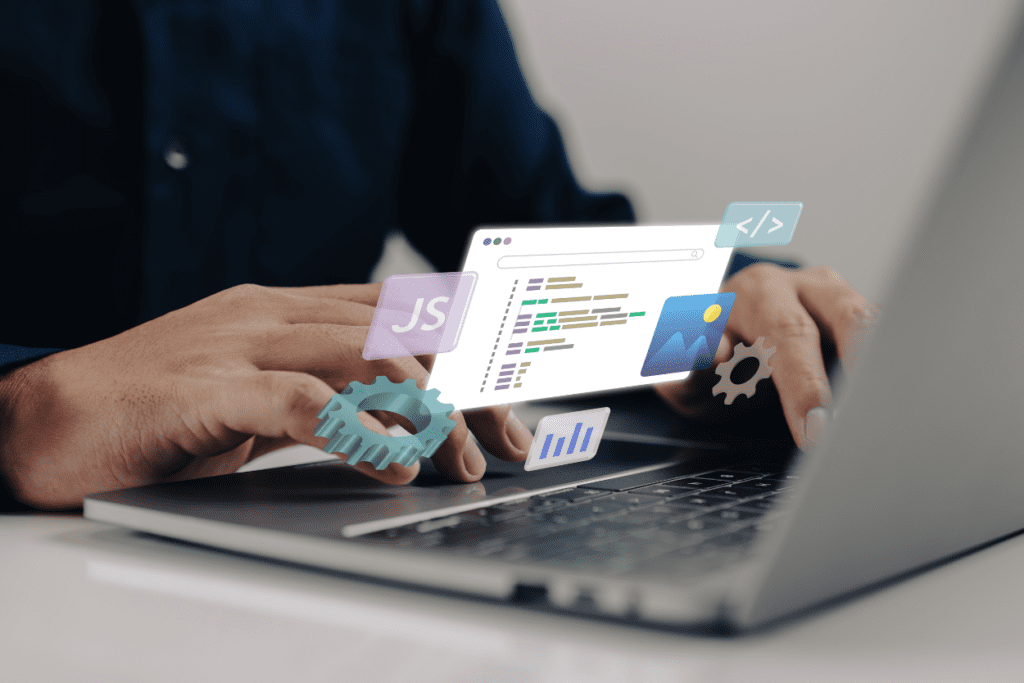- Free Estimates

A website plays a crucial role in the growth and development of a business by significantly expanding its reach and having a well-designed and functional website can set a small business apart from its competitors. Whether you are looking to build a new site from scratch or enhance an existing one, it’s essential to approach website development with a clear strategy and the right tools.
● Key Takeaways
● Introduction
● 1. Choose the Right Platform
● 2. Focus on User Experience (UX)
● 3. Implement Effective SEO Strategies
● 4. Leverage Visual Design Elements
● 5. Utilize Call-to-Action (CTA) Buttons
● 6. Ensure Website Security
● 7. Regularly Update and Maintain Your Site
● Frequently Asked Questions
➤ Select a website platform that is not only user-friendly but also scalable to accommodate your growing business needs.
➤ In website development, prioritize ease of navigation and optimal load times to enhance user satisfaction and retention.
➤ Utilize SEO techniques to boost your website’s visibility and attract more organic traffic.
➤ Use appealing visuals and a cohesive color scheme to make your site stand out and keep visitors engaged.
➤ Strategically place clear and compelling CTAs during website development to guide users toward desired actions and increase conversion rates.
➤ Protect your site and users’ data by implementing robust security measures like SSL certificates and regular security audits.
➤ Keep your website current and functional by conducting regular updates, backups, and performance reviews..

To help you kick-start your journey, here are seven beginner-friendly website development tips and tricks to make a strong online impact.
When starting website development, one of the first important steps is choosing the right platform. This decision affects how your site looks, works, and grows with your business. Popular options include WordPress, Squarespace, and Wix. Choosing well matters because a high-quality website leads to better business performance. So, pick a platform that helps your site look good and work well, as it can really help your business succeed.
User Experience (UX) is a critical component of successful website development. It refers to how a visitor interacts with your website and how easy or satisfying that interaction is. The importance of UX cannot be overstated, as it directly impacts the effectiveness of your site in fulfilling user needs and achieving business goals.
Search engine optimization (SEO) is an essential component of website development that ensures your site is visible to potential customers when they search for relevant terms on search engines like Google. Understanding and implementing effective SEO strategies can dramatically improve your website’s online presence and drive more organic traffic.
In website development, SEO involves a variety of techniques designed to help your website rank higher in search engine results pages (SERPs). The primary goal is to increase the visibility of your site, making it easier for potential customers to find you. The basics of SEO include on-page optimization (like content and keywords), off-page optimization (such as backlinks), and technical SEO (which covers website structure and indexing).
Optimizing your content is vital for effective SEO in website development. Here are some crucial steps to consider:
A well-organized website structure not only improves user experience but also boosts your SEO efforts. Here are some tips for optimizing your website structure during website development:
Visual design in website development is not just about making a site look attractive—it plays a pivotal role in engaging users and encouraging them to spend more time on your website. Effective visual design enhances user experience, promotes brand identity, and can significantly influence visitor behavior.
Here’s how you can optimize the visual design elements of your website:
Call-to-Action (CTA) buttons serve as the critical link between site engagement and customer action. These buttons are not just part of the website’s aesthetic but are strategic tools that guide users towards business goals, such as purchasing a product, signing up for a newsletter, or scheduling a consultation. Effective CTAs convert passive website visitors into active participants, directly influencing conversion rates and the overall success of the website.
Ensuring the security of your website is a critical component of website development, especially for small business owners who often handle sensitive customer information. Here are some common security threats and outline best practices to secure your website effectively:
Security threats can vary widely, but some are more prevalent than others. Here are the most common ones that small business owners should be aware of:
In website development, maintaining strong security measures is non-negotiable. Here are some best practices to help ensure your website remains secure:
Maintaining a website is not just about launching it; it’s about keeping it up to date and functioning optimally over time. Regular updates and maintenance are crucial components of effective website development, ensuring that your site remains secure, fast, and relevant.
Technology and trends evolve rapidly. A website that isn’t regularly maintained can quickly become outdated, which can affect user experience and diminish your brand’s perception.
Regular maintenance is essential for routine updates to fix vulnerabilities and protect against cyber threats. It’s also relevant for regular optimizations to help your website run faster and more efficiently.
Common programming languages for website development include HTML, CSS, and JavaScript for frontend development. Backend development often uses languages such as PHP, Ruby, Python, and Java. JavaScript frameworks like React, Angular, and Vue.js are also popular for dynamic and responsive designs.
The time to develop a website can vary widely depending on its complexity, the technologies used, and the team’s expertise. A basic website might take a few weeks, while a complex, feature-rich website could take several months or more to develop properly.
Web design focuses on the aesthetics and usability of a website, involving the layout, color scheme, and user interface design. Web development, however, is the coding and programming that powers the website’s functionality.
Web developers use a variety of tools to design, code, test, and optimize websites. Common tools include text editors (e.g., Visual Studio Code, Sublime Text), version control systems (e.g., Git), and frameworks/libraries (e.g., React, Angular, Node.js), as well as development and debugging tools integrated into web browsers like Chrome DevTools.
Web development is typically divided into three types: front-end, back-end, and full-stack. Front-end development focuses on the user interface, using languages like HTML, CSS, and JavaScript to create and manage the visual and interactive aspects of a website. Back-end development manages server-side functions involving database interactions and server logic with languages such as Python, Ruby, and PHP. Full-stack development combines both, allowing developers to handle all aspects of web construction and management, from front to back.
Unlock the potential of your business with a professionally designed website from Miami Website Design Professionals. Whether you’re looking to increase sales, reach a broader audience, or simply establish a stronger online presence, our team of experts is here to help. Miami Website Design Professionals specialize in creating custom websites that are not only visually appealing but also optimized for performance and user experience.
Don’t let another day pass without maximizing your business’s online potential. Contact Miami Website Design Professionals today, and let’s start building a website that truly represents the best of your brand.